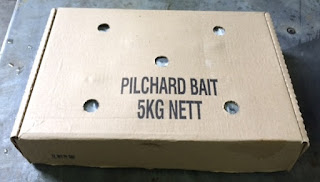Since the start of the South African pilchard season which commenced upon receipt of their respective right holder permits from DAFF earlier this year, the season started off slowly with intermittent periods of good catches. With the pilchards (Sardinops Sagax) having little or no presence around the Cape Of Good Hope, the vessels have been in search of the shoals around Mossel Bay and further up the coast with some success.
With the development of the Mauritius Free Port Development (MFRP), fishing companies have diverted their vessels in favor of the duty / tax free advantage afforded to them by the Mauritian Government instead of docking and discharging in Cape Town with the South African political environment. Adjacent to the seaport of Port Louis, Mauritius's largest port, has developed the largest logistics center in the Indian Ocean. Which offers world-class, cost-effective supply chain solutions through a comprehensive range of equipment and facilities which comply with the highest standards in the industry: EU, HACCP, ISO. Some of the facilities and services on offer are: freight forwarding, customs clearance, transport/ haulage, office rental, dry and cold warehousing, cold storage, container services, dry docking and a seafood hub. The main attraction for vessel owners would be the following:
Zero percent corporate tax,
Preferential markets access (subject to meeting rules of origin requirements)
Exemption from customs duties on all goods imported into the Free Port zones
Free repatriation of profits
Access to offshore banking facilities
Reduced port handling charges for all goods destined for re-export
Hundred per cent foreign ownership
Fifty per cent of re-export value to the local market
It really makes complete sense for a vessel owner to rather call on Port Luis for discharging and resupply. This is why this destination has seen the majority of the South Africa pilchard bait sales with the likes of MSC shipping the bulk of the volume. The local pilchard bait has been traded around $1350/ mt FOB Cape Town, however some volumes has been sold at $1400/ mt FOB same origin. These prices are looking to drop inline with the competition from Moroccan bait suppliers. Albeit the Moroccan pilchard is a different specie, the South African and Canadian pilchard is in highest demand due to the quality and fat content. However, the vessel owners are now looking to bait their hooks with Canadian herring as a substitute based upon the reports and interest received from the Fijian long liners success. The herring was being sold around $1120/ mt CFR Port Luis for the 55/65 jumble pack, a few weeks back. The South African bait suppliers have changed their packaging to the 10kg boxes as per some customers request. This is a more efficient way of packing although the presentation and quality is slightly inferior. The 5kg box which has been preferred by some customers increased the suppliers packaging costs and labor time. The local South African tuna pole vessels prefer the 5kg box due to the interleaved finger packing presentation of the pilchards and is less bulky for easier storage on board.
Below on top is the typical 5kg pilchard box:
Below on top is the typical 5kg pilchard box:
With the international sardine bait price expected to decrease, the vessels are looking to catch their quotas as soon as possible making full advantage of the bait prices, weather permitting of course.







